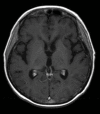A successful treatment of relapsed primary CNS lymphoma patient with intraventricular rituximab followed by high-dose chemotherapy with autologous stem cell rescue
- PMID: 19430564
- PMCID: PMC2678705
- DOI: 10.3349/ymj.2009.50.2.280
A successful treatment of relapsed primary CNS lymphoma patient with intraventricular rituximab followed by high-dose chemotherapy with autologous stem cell rescue
Abstract
The prognosis for patients with primary central nervous system (CNS) lymphoma (PCNSL) who relapse after the initial response is usually poor. A standard treatment for relapsed PCNSL has not yet been identified because of the heterogeneity of the therapies employed and the lack of large, prospective clinical trials. We describe a 46-year-old relapsed PCNSL patient who was successfully treated with intraventricular applications of rituximab to minimize neurotoxicity, 2 cycles of salvage chemotherapy with etoposide, ifosfamide, and cytarabine (VIA) regimen and high-dose chemotherapy with autologous stem cell rescue. The high-dose chemotherapy consisted of bischloroethylnitrosourea, etoposide, cytarabine, and melphalan (BEAM) regimen. Partial remission was detected after intraventricular rituximab therapy and the patient has been in complete remission without evidence of neurotoxicity for 28 months after high-dose chemotherapy with autologous stem cell rescue. This case indicates a new appropriate treatment guideline in relapsed PCNSL patient after initial intensive chemo-radiotherapy.
Keywords: Primary central nervous system lymphoma; high-dose chemotherapy with autologous stem cell rescue; rituximab; salvage therapy.
Figures



References
-
- Batchelor T, Loeffler JS. Primary CNS lymphoma. J Clin Oncol. 2006;24:1281–1288. - PubMed
-
- Ferreri AJ, Reni M, Villa E. Therapeutic management of primary central nervous system lymphoma: lessons from prospective trials. Ann Oncol. 2000;11:927–937. - PubMed
-
- Ferreri AJ, Reni M, Pasini F, Calderoni A, Tirelli U, Pivnik A, et al. A multicenter study of treatment of primary CNS lymphoma. Neurology. 2002;58:1513–1520. - PubMed
-
- Reni M, Ferreri AJ. Therapeutic management of refractory or relapsed primary central nervous system lymphomas. Ann Hematol. 2001;80(Suppl 3):B113–B117. - PubMed
Publication types
MeSH terms
Substances
LinkOut - more resources
Full Text Sources
Other Literature Sources

